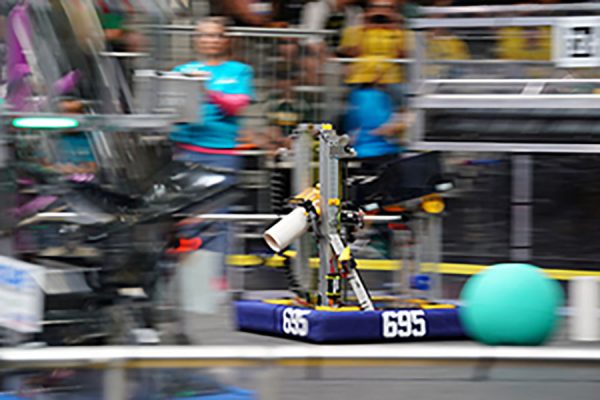Administration Implements Digital Hall Pass, Addresses Compliance Concerns
“When you either scan the QR code or use the link in Google Classroom, you fill out the form, and that form timestamps on a Google spreadsheet that [administrators] and teachers have access to what time a student signs out,” social studies teacher Joe Petraiuolo said.
Staff members felt that too many kids were hanging out in the hallway this fall when they should have been in class.
They turned to technology for a solution with a new digital hall pass, implemented in February. This system allows staff to keep track of where and when students are in the hallways.
Social studies teacher Joe Petraiuolo explained how it works.
“When you either scan the QR code or use the link in Google Classroom, you fill out the form, and that form timestamps on a Google spreadsheet that [administrators] and teachers have access to what time a student signs out,” he said. “All teachers have access to the Google Sheet, which provides the names and times and the location of where you went.”
Principal Paul Chase also gave some insight into the way the policy was developed.
“We have teams that meet together on Friday mornings and Wednesday mornings that look at how we can solve student issues,” he said. “One of the issues we [addressed] is that a lot of students are asking to leave to go use the restroom, go charge their computer, go see the nurse–1000 other reasons–way too often, and to be honest with you, some people [leave class] a lot more than others.”
Technology teacher Chris Croftcheck feels that the hall pass is useful for students and parents.
“It’s a good tool just to let students know that, hey, if you’re leaving for that long, it’s not good,” he said. “You’re not going to be as productive in class. You’re not going to [learn as much] or get as much of your work done because you’re missing so much [class] time.”
Croftcheck said the hall pass can be used to notify parents of the problem.
The school is now implementing a similar digital check in system using a QR code for academy attendance as well.
However, in the first few weeks of implementation of the digital hall pass, students reported observing others skipping the pass when they left class.
“They don’t care enough to do it,” junior Dylan Ornstein said.
“I think a lot of people [just put their] phone up and put it back down to [make it look like you’re scanning] something,” junior Aytan Hochheiser said. “It’s not gonna stop kids [from pretending to scan it].”
Chase acknowledges that the system is new, but says that he and Asst. Principal Aubrei Erkins have been able to use the data to cut down on rulebreakers and contact parents if needed.
Additionally, he and Erkins have been running check-in sessions with students who either use the hall pass for extended times or who have not been using it at all.
“We started off with, I think, 12 students that we spoke to,” he said.
“In some of the sessions, we did have to make parent phone calls, because it just didn’t improve,” he added. “We’ll follow up again in about 10 days to see if there is an improvement.”
Ten days later, Chase sent an email to all students regarding some improvements with the process and issues in student compliance with the hall pass.
“We have also noticed that some of you are not “signing out” when leaving the classroom,” Chase wrote in an email to students on March 9. “Ms. Erkins and I will be doing random checks of the digital spreadsheet beginning Friday. This means if we see you in the hallway during one of your class periods, we will be checking to see if you have ‘signed out’.”
“In addition, your teachers will let Ms. Erkins and me know if you are not using the digital hall pass,” he added. “I understand that students are out of class at various times for various reasons. Please make sure you are signing out.”
While administrators and some teachers seem to appreciate the system, the response from many students has been negative.
“You can just tell the teachers where you’re going; doing this whole hall pass thing is just another step,” sophomore Evan Tew said.
“Just let everyone go back to normal because the people who are going to take class seriously are going to stay, but the people who just want to walk out and just wander, let them do that,” junior Robert Friedman said.
Many students also believe that it doesn’t stop people from hanging out in the halls.
“It literally doesn’t do anything,” junior Dylan Ornstein said. “The kids that stay in the hall, still stay in the hall. It’s pointless.”
Some students also feel that the new system disrupts learning.
“You gotta raise your hand and ask ‘Hey, can I go to the bathroom?’” Hochheiser said. “You’ve got to interrupt class. Got to take your phone out or pull your computer out. You’ve got to sign out. You’ve got to put your phone back or computer back. You’ve got to walk there. Got to get back into class, interrupt class again, because you need to take out your computer or your phone.”
“I feel like that’s on the school to make sure the kids don’t stay in the hall for 10 plus minutes, Not on the student,” Ornstein added.
While many students don’t see the point in using this system and try to find ways to avoid it, others understand its purpose.
“I think the system is worth it, if they’re having a problem with people leaving their classes I think it’s probably worth it for us to have that system,” senior Jonah Wolfe said.
“If I was a teacher and I had a problem with a person leaving the class a lot, I’d probably feel better if I knew it was getting tracked and counted, because then maybe that administration will do something about the kids so I don’t have to do something about it,” he added.
Chase wants to see more data before evaluating the policy’s success.
“This data is new, so there is not enough time to do a comparison,” he wrote in an email “However, individual students have improved after our initial meetings.”
Most students interviewed believe that the digital hall pass system is ineffective at reducing time spent in the hall.
“Some kids don’t care if they’re being tracked for time because they don’t care about school in the first place,” Tew said. “So it’s almost like you’re just tracking how much they don’t care.”
“It doesn’t reduce the time,” says Hochheiser. “Kids are still out for 20 minutes in math class. You know… it’s not any different.”
Some suggest there might be other approaches to the problem.
“Maybe it’s worth having a … hall monitor,” Wolfe said. “If we are having a problem with people leaving a lot then I feel like that might be useful.”

Maurice Kaplan began writing for the Beachcomber in spring 2023. He covers breaking news in the school. When not writing articles, he practices...

Isaac Gorodeski began writing for the Beachcomber in February of 2022. He is interested in writing on current events and many other topics. When not writing...



!["When you either scan the QR code or use the link in Google Classroom, you fill out the form, and that form timestamps on a Google spreadsheet that [administrators] and teachers have access to what time a student signs out,” social studies teacher Joe Petraiuolo said.](https://bcomber.org/wp-content/uploads/2023/03/IMG_3394-660x900.jpg)









